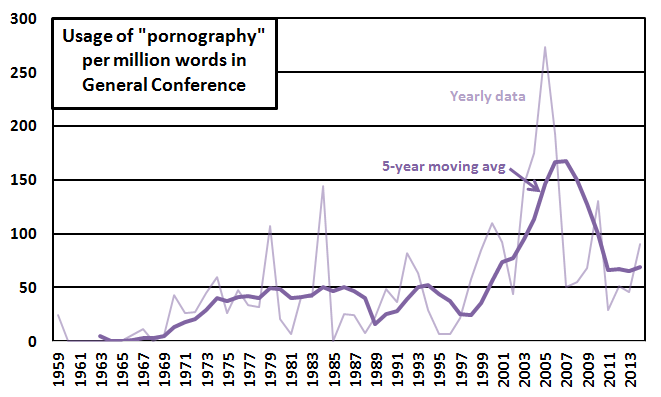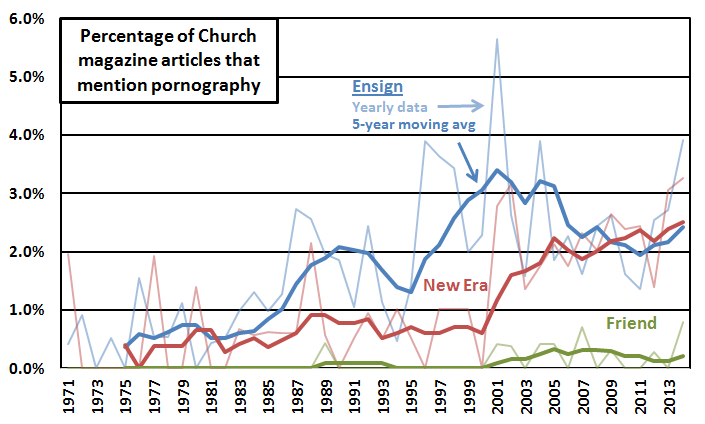In her post last week on Mormon fixation with small issues at the expense of larger more important ones, Jana Riess pointed out that the majority of all references to pornography that have ever been made in General Conference have occurred just since the turn of the millennium. I thought it might be interesting to look at the data in a little more detail, because it was my impression that discussion of porn might be declining.
I looked up the yearly rates of usage of the word “pornography” in General Conference at the LDS General Conference Corpus site. Here’s a graph showing the yearly rates and the five-year moving average. The graph starts in 1959 because that’s the first year pornography was mentioned in Conference.
 It looks like usage might have flattened out again after a big bump in the 2000s. I would guess that the big bump occurred as the internet grew and internet porn grew with it. I wonder if its usage then declined again because no one issue can be the hot topic forever. Maybe something like gay marriage took its place as the topic of the moment.
It looks like usage might have flattened out again after a big bump in the 2000s. I would guess that the big bump occurred as the internet grew and internet porn grew with it. I wonder if its usage then declined again because no one issue can be the hot topic forever. Maybe something like gay marriage took its place as the topic of the moment.
I also counted articles in Church magazines that mention pornography. To find these, I used Google to search each magazine in turn. The search I used was “pornography site:lds.org/ensign” (subsituting “new-era” and “friend” in turn for “ensign.” To avoid double-counting, I didn’t include articles from Ensign issues that report General Conference. To be able to convert the counts of articles to percentages of articles in each year, I estimated the total articles for each year by counting articles in the March and September issues of each magazine and multiplying by 6 (since I was sampling 1/6 of the year).
Here is the result. As in the graph above, each magazine’s year-to-year counts are in faded colors, and the five-year moving averages are in more saturated colors.
 The Ensign data looks kind of like the General Conference data, except the bump occurs earlier. The New Era has had the increase, but hasn’t had the decline. This is somewhat consistent with the modesty rhetoric trend I blogged about earlier this year, where references in the New Era have increased dramatically in the last few years. The connection makes sense given that, as many commenters on the modesty rhetoric thread pointed out, some General Authorities do appear to see immodest dress as a kind of porn (as Elder Oaks famously said, for example).
The Ensign data looks kind of like the General Conference data, except the bump occurs earlier. The New Era has had the increase, but hasn’t had the decline. This is somewhat consistent with the modesty rhetoric trend I blogged about earlier this year, where references in the New Era have increased dramatically in the last few years. The connection makes sense given that, as many commenters on the modesty rhetoric thread pointed out, some General Authorities do appear to see immodest dress as a kind of porn (as Elder Oaks famously said, for example).
I’m interested to hear if you have any thoughts on what these patterns might mean. I think it’s entirely possible, for example, that the five-year moving averages aren’t smoothing the data enough, and that the only real pattern is an increase in recent years since the rise of internet porn. Anyway, hit me with your theories!
My question: Why would the Friend even mention it at all?
Yeah, I’m with Top Hat.
Many children start viewing pornography around age nine, before For The Strength of Youth is in their hands, and often before they start really listening to Conference Talks. Pornography is likely mentioned in The Friend as a way of opening up the topic for discussion.
IME, the articles in the friend take the form of stories (based on true stories) in which a child either finds it discarded in a park or playground and throws it away, or has a friend who tries to show them something, and they refuse to be drawn in. There’s generally an injunction to tell a trusted adult if someone tries to show them something that makes them feel uncomfortable. In the broad brush way of not being able to describe what it is, there maybe a vague description that there’s nudity.
Is this a uniquely Mormon trend or has there been a broader increase in anti-pornography rhetoric in the US over this time span?
That’s a great question, Thokozile. I’ll have to think if I can come up with any way of answering it. Or I’d love to hear if anyone else has ideas!
Hedgehog, that seems reasonable, but if I understand Ziff’s analysis correctly, the counts displayed in the graph are the number of times the word “pornography” appears, and therefore wouldn’t include related words and/or euphemism. Ziff, is that right?
If that’s correct, then I’m pretty disturbed by the Friend data. Speaking in general terms about not looking at things that make you feel uncomfortable is pretty different than explicitly advising about pornography.
On a related note, I also wonder if part of the uptick in the 80’s and 90’s is because in earlier decades writers were more likely to use euphemisms for pornography than the word itself–I seem to recall terms like “salacious material” and so forth.
Laura, they did use the word pornography, but didn’t explain what it was other than vague allusion to nudity, leaving the rest to parents.
Recent conferences it’s a subject that has migrated from the priesthood session to the general sessions I’ve noticed.
Also, I was 10 when a friend snuck some of her father’s porn into school and that was 35 years ago. I don’t think the situation now is better.
Laura, you’re right that I searched for the actual word “pornography” and not for any related words or euphemisms.
If you want to look at them, here are the references to pornography that I found in the Friend:
https://www.lds.org/friend/2014/02/oh-no-now-what?lang=eng
https://www.lds.org/friend/print/2004/03/the-decision?lang=eng&clang=eng
https://www.lds.org/friend/2005/09/trying-to-be-like-jesus/avoiding-evil?lang=eng
https://www.lds.org/friend/2007/06/deadly-maka-fekes?lang=eng
https://www.lds.org/friend/print/2012/09/show-and-tell?lang=eng&clang=eng
https://www.lds.org/friend/2009/10/guide-to-the-friend?lang=eng
https://www.lds.org/friend/2014/02/dear-parents-and-teachers?lang=eng
https://www.lds.org/friend/2014/05/conference-notes?lang=eng
https://www.lds.org/friend/2001/06/be-a-standard-bearer?lang=ita&clang=eng
https://www.lds.org/friend/2007/08/a-voice-of-warning?lang=eng
https://www.lds.org/friend/1989/06/to-the-children-of-the-church?lang=eng
https://www.lds.org/friend/print/2002/01/come-listen-to-a-prophets-voice-gods-power-within-you?lang=eng&clang=eng
Alright, I’ll concede, that seems much more reasonable than I first thought.
Yeah, those are acceptable.
One of my siblings found a magazine that blew across to the local playground from a nearby building site, and told me to come look at what they’d found – they were probably 9 and 11, I would have been 12. So, something that says “tell an adult if you see something that makes you uncomfortable” is pretty reasonable.
One can only hope that the youth magazines are as reasonable
I guess my main thought is, “Are we done yet? Can we stop now?”
Unfortunately, most JC Penney Sunday newspaper supplement brassiere ads would probably be “pornography” by GC talk standards, so I take the whole thing with a grain of salt. Personally, I’m tired of hearing how depraved I am and how bare shoulders are a sure sign of the imminent Second Coming.